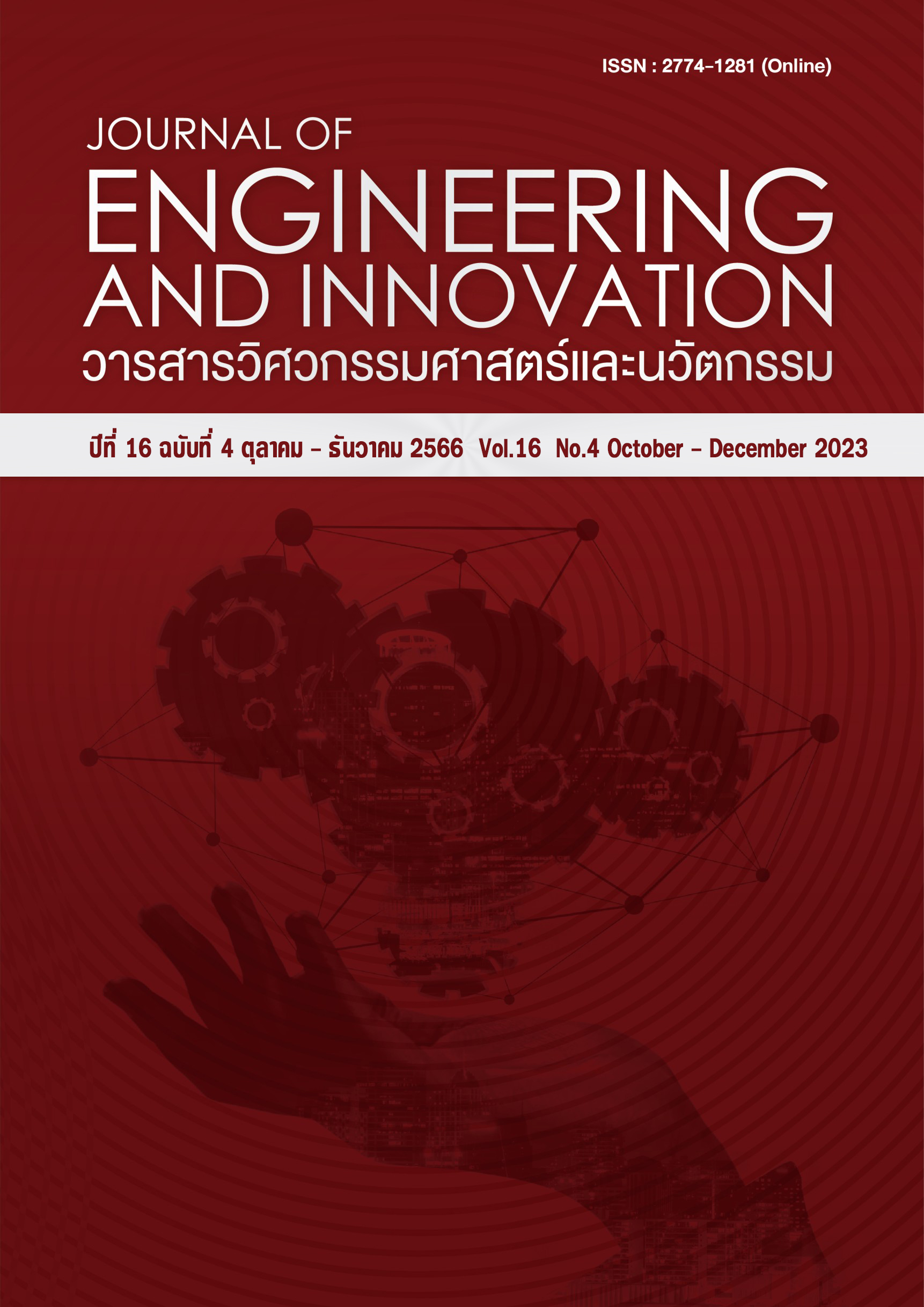Development of Accumulated Surface Fuel Determination Process Using Canopy Image Process Technology in Deciduous Dipterocarp Forests
Main Article Content
Abstract
This research article aims to the data in the development of the accumulated fuel content in the deciduous dipterocarp forest at Lam Nam Nan National Park, Uttaradit province. There is an area of 100 Rai of deciduous dipterocarp forest, with a total of 5 data collection points. That is based on the criteria for the collection point at an altitude of 400 - 600 meters above sea level, with a slope of 8 - 10 degrees at an angle to the horizontal level. The image acquisition takes a picture and collecting time is always taking every week. Then, researcher will develop a system to retrieve data and use the canopy photo for analysis to adjust the white/black tones. The image data frame used to define the canopy cover behavior as a percentage area. Approximately 85 - 95 percentages. The results of the analysis revealed that the time when the canopy did not defoliate, it was about 85 - 95 percentages. When converted to the amount of fuel accumulated on the surface below the canopy was approximately 0.04 - 0.11 kilograms per square meter. Which is the beginning of the forest fire season in Thailand. The percentage of black pigment grain are is in the range of 20 - 30 percentages. Which is equivalent to the amount of fuel accumulated on the area of approximately 0.33 - 0.48 kilograms per square meter. The data was used to generate trends in fuel accumulation on the soil surface of the deciduous dipterocarp forest to extend the results to forecast the fuel accumulate in deciduous dipterocarp forests. The amount of fuel accumulated on the surface of the soil can be predicted from the canopy photograph under the aforementioned conditions. There is a tolerance of 18%. It can also be used for decision support in fuel management.
Article Details
References
กรมอุทยานแห่งชาติสัตว์ป่าและพันธุ์พืชกระทรวงทรัพยากรธรรมชาติและสิ่งแวดล้อม. ยุทธศาสตร์/มาตรการแก้ไขปัญหาไฟป่าและหมอกควันปี 2556.
นวพล ลินต๋า. การหาพื้นที่เผาไหม้จากไฟป่าด้วยภาพดาวเทียม Sentinel-2 กรณีศึกษา อำเภอปาย จังหวัดแม่ฮ่องสอน [วิทยานิพนธ์ปริญญาตรี]. ภาควิชาทรัพยากรธรรมชาติและสิ่งแวดล้อม คณะเกษตรศาสตร์ ทรัพยากรธรรมชาติ และสิ่งแวดล้อม มหาวิทยาลัยนเรศวร; 2563.
พงษ์ธร วิจิตรกูล, การศึกษาปัจจัยที่มีผลต่อความรุนแรงไฟในป่าเต็งรัง, ใน: การประชุมวิชาการเครือข่ายวิศวกรรมเครื่องกลแห่งประเทศไทย ครั้งที่ 26 ME-NETT, มหาวิทยาลัยเทคโนโลยีพระจอมเกล้าธนบุรี; 2555. 225-236.
พงษ์ธร วิจิตรกูล. การจำลองรูปแบบการจัดเรียงตัวของตอซังข้าวที่มีผลต่อความรุนแรงไฟ, วารสารเทคโนโลยีอุตสาหกรรม มหาวิทยาลัยราชภัฏอุบลราชธานี (Journal of Industrial Technology Ubon Ratchathani Rajabhat University), อุบลราชธานี. ปีที่ 8 ฉบับที่ 2 กรกฎาคม - ธันวาคม 2561. น. 155 – 168.
พงษ์ธร วิจิตรกูล. การประเมินค่าความร้อนจำเพาะของเชื้อเพลิงเพื่อพัฒนากระบวนการช่วยตัดสินใจชิงเผาป่าเต็งรัง กรณีศึกษา: เขตอุทยานแห่งชาติลำน้ำน่าน จังหวัดอุตรดิตถ์ (ประเทศไทย), วารสารวิชาการมหาวิทยาลัยราชภัฏอุตรดิตถ์ สาขาวิทยาศาสตร์และเทคโนโลยี (เพื่อการพัฒนาท้องถิ่น), ปีที่ 16 ฉบับที่ 2, กรกฎาคม - ธันวาคม 2564. น. 1-12.
ปัญญากร ดีเรือน และ วัชรพงษ์ ธัชยพงษ์. การวิเคราะห์ค่าความร้อนของใบไม้เพื่อทำนายความรุนแรงของไฟป่าเต็งรัง. ใน: นุชิดา สุวแพทย์, บรรณาธิการ. การประชุมวิชาการเครือข่ายวิศวกรรมเครื่องกลแห่งประเทศไทย ครั้งที่ 33; 2 – 5 กรกฎาคม 2562; มหาวิทยาลัยมหาสารคาม (มหาสารคาม); 2562. น. 135 – 141.
Alan A. Ager et al. Using transboundary wildfire exposure assements to improve fire management programs: a case study in Greece. International Journal of Wildland Fire 2018; 27: 501-513.
Crowe, A. R. a. K. A. A simulation-optimization model for selecting the location of fuel-breaks to minimize expected losses from forest fires. Forest Ecology and Management 2010; 260: 1-11.
Curt T, Frejaville T. Wildfire policy in Mediterranean France: How far is it efficient and sustainable. Risk Analysis 2017; 38: 472-488.
David A. Schmidt, Alan H. Taylor and Carl N. Skinner. The influence of fuels treatment and landscape arrangement on simulated fire behavior, Southern Cascade Range, California. Forest Ecology and Management 2008; 255: 3170-3184.
Jennifer Sherry, Timothy Neale et a., Rethinking the maps: A case study of knowledge incorporation in Canadian wildfire risk management and planning. Journal of Environmental Management 2019; 234: 494-502.
Joaquim Sande Silva et al., Toward integrated fire management to promote ecosystem resilience. Society for Range Management 2022; 44(3): 227-234.
Kraisorn Wiriya and San Kaitpraneet. Fire Behavior in Dry Deciduous Dipterocarp Forest at Huai Kha Khaeng Wildlife Sanctuary, Uthai Thani Province. Kasetsart Journal (Natural Science) 2009; 43: 41-47.
Kazuya Kaku. Sentinel Asia Evolution. 1 st JPTM for Sentinel Asia Step 3. 2013 November 27-29. Japan Aerospace Exploration Agency Satellite Applications and Promotion Center. Tokyo. Japan.
Lara A. Arroyo., Cristina Pascual. and Jose A. Manzanera. Fire models and methods to map fuel types: The role of remote sensing. Forest Ecology and Management Journal 2008 ; 256(6): 1239–1252.
Nalamphun, A., T. Santisuk and T.Smitinand. The defoliation of Teng (Shorea obtuse Wall) and Rang (Pentacme suavis A.DC.) at ASRCT Sakaerat Experiment Station. Journal of Biogeography 1986; 13: 345-358.
Pedro M. Palheiro., Paulo Fernandes and Miguel G. Cruz. A fire behaviour-based fire danger classification for maritime pine stands: Comparison of two approaches. Forest Ecology and Management Journal 2006; 234 : 1-12.
Somchai Pienstaporn. Forestry in Thailand, Forest Fire Control in Thailand. Forest Fire Control Division Royal Forest Department. Chaiyasit Liengsiri, editor. Bangkok; 2009.
Sharon London. Community-Based Fire Management in Lao People’s Democratic Republic: Past, Present and Future. Project Fire Fight Sou East Asia, A Global Initiative of the World Conservation Union (IUCN) and the World Wide Fund for Nature (WWF) International. Center for International Forestry Research (CIFOR). 2001 October; Jakarta, Indonesia.

